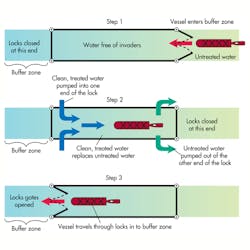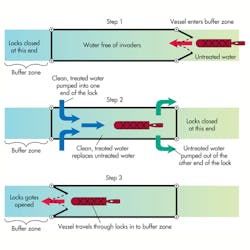Locks On Rivers That Stop Invading Species
Around 1900, civil engineers connected the Great Lakes to the Mississippi River Basin to let shippers access both waterways. But within the past 30 years, biologists and the Army Corp of Engineers have been trying to keep aquatic species from moving out of native habitats in the Great Lakes and into the Mississippi River Basin and vice versa. Currently, professional and amateur fishermen in the Great Lakes, along with the area’s tourist industry, are desperately seeking ways to prevent Asian carp from getting from the Mississippi into Lake Michigan, a gateway to the rest of the Great Lakes and St. Lawrence Seaway. One method being suggested are a series of locks with special provisions for keeping fish and other aquatic species from getting through.
Once sufficient time has passed to allow all the water to be exchanged, the far gates open and the ship passes through, without any hitchhiking fish or plants. The Corp of Engineers estimate such a project could cost $15 billion and take 25 years.

